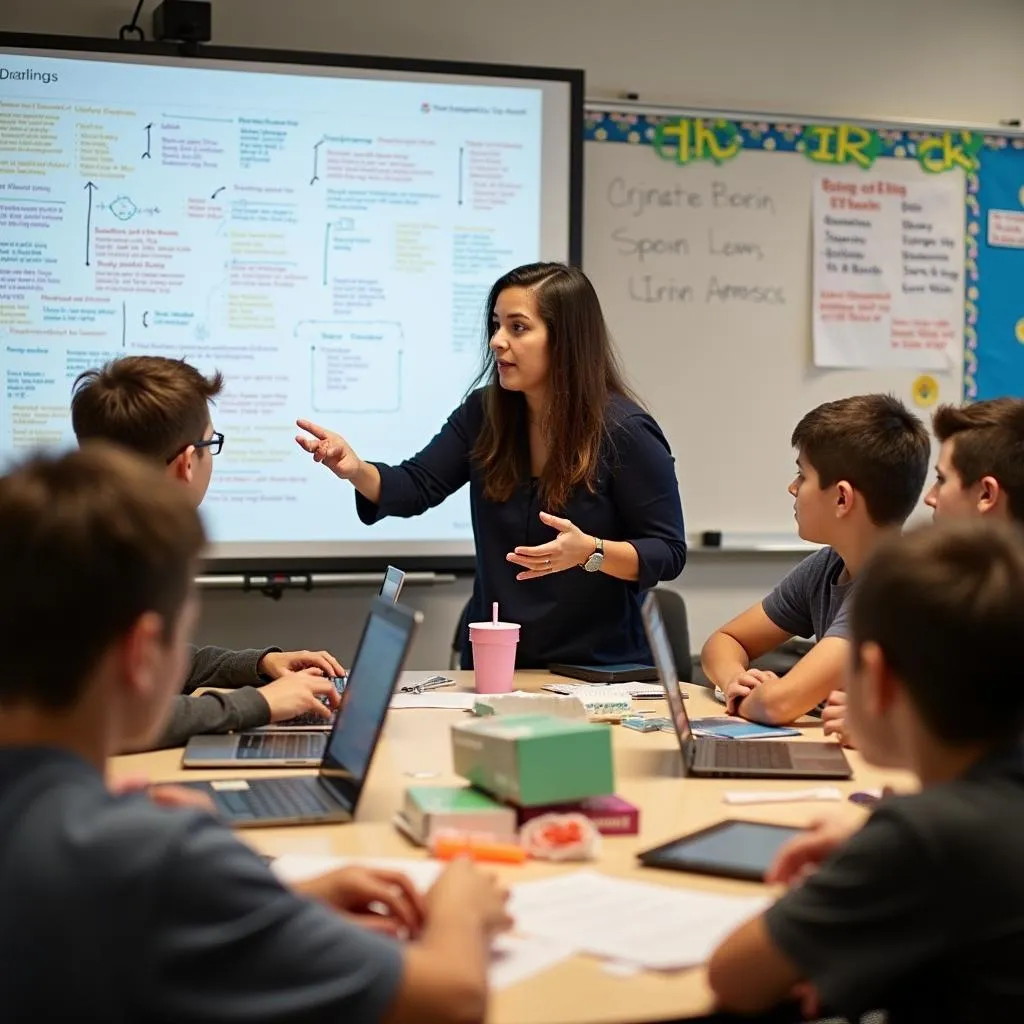Problem-solving is a crucial skill that IELTS examiners often assess in the Speaking test. This topic frequently appears in Part 2 and Part 3 of the test, challenging candidates to demonstrate their ability to articulate complex situations and showcase their English proficiency. In this article, we’ll explore effective strategies to excel in describing problem-solving scenarios during your IELTS Speaking exam.
Part 1: Introduction and Interview
In Part 1, the examiner may ask general questions about problem-solving. Here’s an example question with a suggested answer:
Q: How do you usually approach problems in your daily life?
A: Well, when I encounter a problem, I typically try to break it down into smaller, more manageable parts. This allows me to tackle each aspect systematically, rather than feeling overwhelmed by the entire issue at once. I also find it helpful to brainstorm potential solutions and weigh their pros and cons before deciding on the best course of action.
Describe a skill you use in your daily life that can be particularly useful in problem-solving situations. For instance, critical thinking or effective communication can greatly enhance your ability to overcome challenges.
Part 2: Long Turn
Here’s a sample cue card related to problem-solving:
Describe a situation where you had to use your problem-solving skills
You should say:
- What the problem was
- When and where it happened
- How you solved it
- And explain why you think your solution was effective
Sample Answer (Band 6-7):
I’d like to talk about a time when I had to use my problem-solving skills at work. Last year, our team was working on a crucial project for a client, and we encountered a major setback just days before the deadline.
The problem was that our main software crashed, and we lost a significant portion of our work. This happened on a Friday afternoon, and we were supposed to present our findings to the client on Monday morning. It was a stressful situation, to say the least.
To solve this issue, I first called an emergency team meeting to assess the damage and brainstorm solutions. We decided to split into smaller groups, each focusing on recreating a specific part of the lost work. I also reached out to our IT department for help in recovering any data possible from the crashed system.
We worked through the weekend, pulling extra hours to catch up. I made sure to keep everyone motivated and focused on our goal. By Sunday evening, we had managed to recreate most of the lost work and even improve some aspects of our presentation.
I believe our solution was effective because we approached the problem systematically and worked collaboratively. We not only met the deadline but also delivered a high-quality presentation to the client, who was impressed with our results.
Sample Answer (Band 8-9):
I’d like to recount a challenging situation that required me to employ my problem-solving skills effectively. This incident occurred during my final year at university when I was leading a team for our capstone project in environmental engineering.
The crux of the problem was that our innovative water purification system, which we had been developing for months, unexpectedly malfunctioned during a crucial testing phase. This setback happened just two weeks before our final presentation to a panel of industry experts and potential investors. The malfunction threatened to derail our entire project and jeopardize our graduation prospects.
To address this critical issue, I immediately initiated a comprehensive troubleshooting process. First, I convened an emergency team meeting to conduct a thorough analysis of the system’s components. We methodically examined each element, from the filtration membranes to the control software, to identify the root cause of the malfunction.
After pinpointing the problem – a faulty sensor that was providing incorrect data to the control system – we devised a multi-pronged approach to resolve it. I delegated tasks based on team members’ strengths: our software expert recalibrated the control algorithms, while our hardware specialist sourced and installed a more reliable sensor. Concurrently, I liaised with our faculty advisor to secure additional lab time and resources to expedite our repair and testing process.
We implemented rigorous quality control measures to prevent similar issues in the future, including redundant sensors and fail-safe protocols. Despite the time constraints, we worked diligently, often pulling all-nighters to ensure we met our deadline without compromising the quality of our project.
The effectiveness of our solution was evident in the outstanding results we achieved. Not only did we successfully repair and improve our water purification system, but we also exceeded the original performance metrics. Our presentation to the panel was met with acclaim, and we secured funding to further develop our project into a viable product for real-world application.
This experience was invaluable as it honed my ability to remain calm under pressure, think critically in high-stakes situations, and lead a team through adversity. It reinforced the importance of adaptability, collaborative problem-solving, and maintaining a positive attitude in the face of seemingly insurmountable challenges.
Follow-up Questions:
- How did you feel when you first encountered the problem?
- What was the most challenging aspect of solving this problem?
- How has this experience influenced your approach to problem-solving in your current work or studies?
Sample Answers:
Band 6-7:
-
When I first encountered the problem, I felt quite anxious and overwhelmed. The deadline was looming, and the loss of our work seemed catastrophic at first.
-
The most challenging aspect was managing the team’s morale while under such intense pressure. It was difficult to keep everyone motivated and focused when we were all stressed and tired.
-
This experience has made me more proactive in my approach to problem-solving. I now try to anticipate potential issues before they arise and always have a backup plan in place.
Band 8-9:
-
Initially, I experienced a surge of adrenaline coupled with a momentary sense of panic. However, I quickly composed myself, recognizing that maintaining a clear head was crucial for effective leadership in this crisis.
-
The most challenging aspect was balancing the technical demands of repairing our system with the need to manage team dynamics under extreme pressure. Ensuring that each team member remained motivated and focused, while also addressing their concerns and potential burnout, required constant attention and emotional intelligence.
-
This experience has profoundly shaped my problem-solving approach. It has instilled in me the importance of maintaining composure in high-pressure situations and the value of fostering a resilient team culture. I now place greater emphasis on contingency planning and regular risk assessments in all my projects, always preparing for unexpected challenges.
Part 3: Two-way Discussion
In this section, the examiner will ask more abstract questions related to problem-solving. Here are some sample questions and answers:
Q: How important do you think problem-solving skills are in today’s workplace?
A (Band 6-7): I believe problem-solving skills are very important in today’s workplace. Many jobs require employees to think critically and find solutions to various challenges. Companies value workers who can handle unexpected issues efficiently.
A (Band 8-9): In my opinion, problem-solving skills are absolutely crucial in the modern workplace. The rapidly evolving nature of industries, coupled with increasing global competition, necessitates a workforce that can adapt swiftly to new challenges. Employees who can identify issues proactively, analyze complex situations, and implement effective solutions are invaluable assets to any organization. Moreover, as automation continues to reshape job roles, the ability to solve non-routine problems becomes a key differentiator for human workers, making these skills not just important, but essential for career success and organizational growth.
Q: Do you think schools should focus more on teaching problem-solving skills?
A (Band 6-7): Yes, I think schools should definitely focus more on teaching problem-solving skills. These skills are useful not just in work but in everyday life too. Schools could include more practical projects and group activities to help students develop these skills.
A (Band 8-9): Absolutely. I firmly believe that schools should place a greater emphasis on cultivating problem-solving skills. The traditional education model, which often prioritizes rote learning and standardized testing, may not adequately prepare students for the complexities of the modern world. By integrating problem-solving into the curriculum, schools can foster critical thinking, creativity, and adaptability – qualities that are essential in both personal and professional spheres. This could be achieved through project-based learning, interdisciplinary studies, and real-world problem simulations. Such an approach would not only enhance students’ academic performance but also equip them with the mental agility and resilience needed to navigate an increasingly uncertain and rapidly changing global landscape.
 Teaching problem-solving skills in education
Teaching problem-solving skills in education
Q: How has technology changed the way we solve problems?
A (Band 6-7): Technology has greatly changed how we solve problems. We now have access to a lot of information online, which helps us find solutions quickly. Tools like smartphones and computers make it easier to communicate and collaborate with others when solving complex issues.
A (Band 8-9): Technology has revolutionized our approach to problem-solving in myriad ways. Firstly, it has democratized access to information, allowing individuals and organizations to tap into vast knowledge bases and expert opinions almost instantaneously. This has accelerated the problem-solving process and broadened the scope of potential solutions we can consider.
Moreover, advanced technologies like artificial intelligence and machine learning have enabled us to tackle incredibly complex problems that were previously beyond human capacity. These tools can analyze enormous datasets, identify patterns, and generate insights at a scale and speed unattainable by human cognition alone.
Additionally, technology has transformed collaboration in problem-solving. Cloud-based platforms and communication tools facilitate real-time cooperation among geographically dispersed teams, allowing for the pooling of diverse expertise and perspectives. This global collaboration often leads to more innovative and robust solutions.
However, it’s crucial to note that while technology has enhanced our problem-solving capabilities, it has also introduced new challenges, such as information overload and the need for digital literacy. Balancing technological tools with human intuition and critical thinking remains key to effective problem-solving in the digital age.
Describe a time when you had to overcome a major obstacle using technology. This can provide a concrete example of how modern tools and digital resources can be leveraged in problem-solving situations.
Key Vocabulary and Phrases for High Scores
To enhance your IELTS Speaking performance when discussing problem-solving, consider using these advanced words and phrases:
-
To tackle (verb) /ˈtæk.əl/: to make a determined effort to deal with a difficult problem or situation
Example: “We need to tackle this issue head-on.” -
To brainstorm (verb) /ˈbreɪn.stɔːm/: to have a group discussion to produce ideas or solve problems
Example: “Let’s brainstorm some potential solutions to this challenge.” -
To implement (verb) /ˈɪm.plɪ.ment/: to put a plan or system into operation
Example: “After careful consideration, we decided to implement the new strategy.” -
To mitigate (verb) /ˈmɪt.ɪ.ɡeɪt/: to make something less harmful, unpleasant, or bad
Example: “Our goal was to mitigate the negative impacts of the project delay.” -
Innovative (adjective) /ˈɪn.ə.və.tɪv/: introducing new ideas; original and creative in thinking
Example: “We need an innovative approach to solve this complex problem.” -
Resilience (noun) /rɪˈzɪl.i.əns/: the ability to recover quickly from difficulties
Example: “Developing resilience is crucial for effective problem-solving.” -
To streamline (verb) /ˈstriːm.laɪn/: to make a system, organization, or process more efficient and effective
Example: “We streamlined our workflow to improve productivity.” -
Analytical thinking (noun phrase) /ˌæn.əlˈɪt.ɪ.kəl ˈθɪŋ.kɪŋ/: the ability to examine and break down facts and thoughts into their strengths and weaknesses
Example: “Strong analytical thinking skills are essential in this role.”
Describe a situation where you had to be very organized to solve a complex problem. This can demonstrate your ability to use advanced vocabulary in context while discussing problem-solving techniques.
Examiner’s Advice
To achieve a high score in the IELTS Speaking test when discussing problem-solving:
-
Use a variety of complex sentence structures and advanced vocabulary to demonstrate your language proficiency.
-
Provide specific, detailed examples to support your points. This shows your ability to communicate complex ideas clearly.
-
Practice describing problem-solving scenarios using the STAR method (Situation, Task, Action, Result) to structure your responses effectively.
-
Show your ability to discuss abstract concepts by relating problem-solving to broader themes like education, technology, or societal issues.
-
Demonstrate critical thinking by analyzing the effectiveness of different problem-solving approaches and considering alternative perspectives.
-
Use appropriate linking words and phrases to ensure your ideas flow logically and coherently.
-
Engage with the examiner’s questions thoughtfully, showing your ability to think on your feet and provide substantive responses.
By following these strategies and incorporating advanced language skills, you can significantly enhance your performance in the IELTS Speaking test when addressing problem-solving topics.
Describe an outdoor activity that you enjoy doing in your free time that helps you develop problem-solving skills. This can provide a unique perspective on how everyday activities can contribute to improving cognitive abilities relevant to IELTS Speaking tasks.


